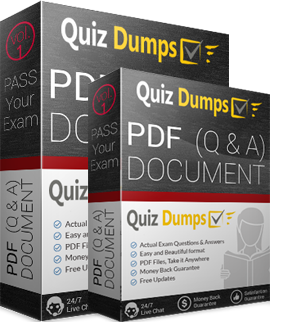CLSSBB-001
Guaranteed Success in CLSSBB-001 Exam
| CLSSBB-001 Exam Dumps PDF + Practice Test | |||
| Exam: | CLSSBB-001 | ||
| Exam Name: | GAQM Certified Lean Six Sigma Black Belt (CLSSBB) Exam | ||
| Certification(s): | Certified Lean Six Sigma Black Belt | ||
| Questions: | 300 Questions Answers | ||
| Last Updated: | May 28,2025 | ||
| Price: | Was: $85 Today: $59 | ||
Check Free Demo Before Buy
$ 49.00 – $ 75.00
Are you looking for real CLSSBB-001 exam questions ? You’re in the right place!
Pass your GAQM CLSSBB-001 exam with the latest QuizDumps PDF Questions & Answers.
QuizDumps offers authentic, updated, and expert-verified CLSSBB-001 braindumps.
Want top scores? Start your prep now with QuizDumps study material.
1: Download Q&A PDF
Buy & Download 100% real, updated and verified exam questions and answers tested and prepared by GAQM experts to pass CLSSBB-001 exam.
2: Prepare
Prepare for CLSSBB-001 with 100% confidence using QuizDumps's CLSSBB-001 exam dumps PDF or CLSSBB-001 practice exam.
3: Pass Your Exam
QuizDumps's CLSSBB-001 exam kit prepares you to confidently ace all CLSSBB-001 questions and pass on your first attempt with top scores.
Comments
Main points of GAQM CLSSBB-001 Test
The GAQM CLSSBB-001 exam, Certified Lean Six Sigma Black Belt, is a comprehensive certification that assesses your knowledge and ability to apply Lean Six Sigma principles and tools in real-world business scenarios.
Here are the main points covered in the exam:
1. Lean Six Sigma Foundations:
- Lean Principles: Understanding the principles of Lean, including value stream mapping, waste elimination, pull systems, and continuous improvement.
- Six Sigma Principles: Understanding the DMAIC methodology, process capability, statistical process control, and data analysis techniques.
- Integration of Lean and Six Sigma: Understanding how to effectively combine Lean and Six Sigma methodologies for maximum impact.
2. Define Phase:
- Project Selection and Charter Development: Identifying and defining impactful projects, developing clear project charters, and securing stakeholder buy-in.
- Voice of the Customer (VOC): Understanding and integrating customer needs and expectations into project goals.
- Problem Statement and Project Scope: Clearly defining the problem statement, establishing project boundaries, and identifying key performance indicators (KPIs).
3. Measure Phase:
- Data Collection and Measurement: Identifying and collecting relevant data, measuring process performance, and developing data analysis plans.
- Process Mapping: Creating detailed process maps, identifying key process steps, and understanding process flow.
- Data Analysis Tools: Utilizing statistical tools like histograms, Pareto charts, and scatter diagrams to analyze data and identify root causes.
4. Analyze Phase:
- Root Cause Analysis: Applying appropriate techniques like Fishbone diagrams, 5 Whys analysis, and Failure Mode and Effects Analysis (FMEA) to identify root causes of problems.
- Hypothesis Testing: Developing and testing hypotheses using statistical methods to validate root cause analysis findings.
- Data Interpretation and Reporting: Communicating findings and insights effectively to stakeholders using charts, graphs, and reports.
5. Improve Phase:
- Developing and Evaluating Solutions: Generating and selecting potential solutions, evaluating their feasibility and impact, and developing implementation plans.
- Process Design and Redesign: Implementing process improvements, redesigning processes for optimal efficiency, and incorporating Lean principles.
- Change Management and Training: Planning and implementing change management strategies, training process stakeholders, and ensuring successful adoption.
6. Control Phase:
- Monitoring and Control: Establishing control plans, implementing process monitoring systems, and tracking performance against KPIs.
- Sustaining Improvements: Ensuring that improvements are sustained over time through ongoing monitoring, continuous improvement efforts, and standardization.
- Documentation and Communication: Maintaining documentation, communicating outcomes to stakeholders, and ensuring knowledge transfer.
7. Leadership and Project Management:
- Team Leadership: Leading and motivating project teams, building consensus, and facilitating effective collaboration.
- Risk Management: Identifying, assessing, and mitigating project risks, developing contingency plans, and implementing risk management strategies.
- Project Communication and Reporting: Effectively communicating project status, progress, and results to stakeholders, and preparing reports and presentations.
8. Advanced Lean Six Sigma Tools and Techniques:
- Design for Six Sigma (DFSS): Understanding and applying DFSS principles to design and develop products and processes for optimal performance.
- Lean Manufacturing and Production: Applying Lean principles to optimize manufacturing processes, reduce waste, and improve efficiency.
- Statistical Process Control (SPC): Understanding and using SPC tools to monitor and control process variability.
- Simulation and Modeling: Utilizing simulation and modeling techniques to evaluate process changes and optimize performance.
9. Industry Applications:
- Understanding Common Industry Challenges: Recognizing and addressing common challenges and opportunities in various industries, such as healthcare, manufacturing, financial services, and IT.
- Applying Lean Six Sigma Across Industries: Demonstrating the ability to tailor Lean Six Sigma methodologies to specific industry contexts.
- Real-World Case Studies: Analyzing and understanding real-world case studies of successful Lean Six Sigma implementations.
Key Exam Details:
- Format: Multiple-choice and scenario-based questions
- Duration: 4 hours
- Passing Score: 70%
- Prerequisites: Certified Lean Six Sigma Green Belt or equivalent experience
This exam tests your ability to apply Lean Six Sigma knowledge and skills in a practical and comprehensive manner. Studying the above concepts and practicing with real-world scenarios will help you prepare for the GAQM CLSSBB-001 exam effectively.
| Exam Code | Certifications | Questions | Comments | Reviews |
|---|---|---|---|---|
| CSM-001 Dumps | Certified Scrum Master | 119 Questions | 10 | 2 |
| CTL-001 Dumps | Certified Team Leader | 70 Questions | 4 | 1 |
| CITM-001 Dumps | Certified Information Technology Manager | 80 Questions | 3 | 0 |
| ISO-31000-CLA Dumps | ISO Certifications | 100 Questions | 1 | 0 |
| CDCP-001 Dumps | Certified Data Centre Professional | 40 Questions | 1 | 1 |
| CDCS-001 Dumps | Certified Data Centre | 40 Questions | 1 | 0 |
| ISO27-13-001 Dumps | ISO Certifications | 100 Questions | 0 | 0 |
| CCCP-001 Dumps | Certified Cloud Computing Professional | 450 Questions | 0 | 0 |
| PPM-001 Dumps | Professional in Project Management | 223 Questions | 0 | 0 |
| ISO-BCMS-22301 Dumps | ISO Certifications | 100 Questions | 0 | 0 |
| CLSSBB-001 Dumps | Certified Lean Six Sigma Black Belt | 300 Questions | 0 | 0 |
| CASPO-001 Dumps | Certified Agile Scrum Product Owner | 80 Questions | 0 | 0 |
| CLSSGB-001 Dumps | Certified Lean Six Sigma Green Belt | 200 Questions | 0 | 0 |
| CFA-001 Dumps | Certified Forensic Analyst | 180 Questions | 0 | 0 |
| BPM-001 Dumps | Business Management Professional | 50 Questions | 0 | 0 |
Why PDF Format?
Our PDF format offers seamless portability across multiple devices, allowing you to study anytime, anywhere. For a more immersive preparation, our Practice Test software replicates the real exam environment. With various testing modes and advanced self-assessment features, our practice exams stand out as the best in the industry.
Is This User Friendly & Easily Accessible on Mobile Devices?
We are committed to delivering precise Certified Lean Six Sigma Black Belt (CLSSBB) Exam questions and answers, accompanied by detailed explanations. At QuizDumps, we value your time and investment, ensuring that every question and answer is thoroughly verified by GAQM experts. Our team consists of highly qualified professionals with years of hands-on experience in the field, guaranteeing reliable and up-to-date exam preparation.
Are All Materials Verified by Experts?
QuizDumps is a trusted name in certification exam preparation, offering [Authentic, Updated, and Real] CLSSBB-001 Dumps, carefully crafted and verified by IT professionals. If you want to achieve top scores, kickstart your preparation today with our comprehensive CLSSBB-001 dumps PDF.
What is Our Commitment !
At QuizDumps, we are committed to helping professionals pass their certification exams in the shortest time possible. Our goal is to provide top-quality study materials and exceptional customer support. We continuously enhance our GAQM CLSSBB-001 exam preparation resources by updating question banks, adding new features, and promptly addressing any reported issues.

